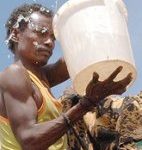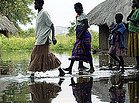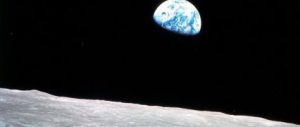It's hard to imagine why humans would have chosen the achingly arid stone desert of Wadi Faynan — in present-day Jordan — for a settlement. But water would have been one important reason, says archaeologist Steven Mithen. When Neolithic men and women arrived 11,500 years ago, things were very different: the climate was cooler and wetter; the landscape was covered in vegetation, including wild figs, legumes and cereals; and there would have been wild goats and ibex for meat.
Initially WF16, as it's now called, would have been a seasonal camp. But Mithen, professor of early prehistory at England's University of Reading, and his fellow archaeologist Bill Finlayson believe that, gradually, people stayed longer. Sifting evidence from so long ago, the archaeologists can't be sure, but remains of food from different seasons and the scale of "rubbish" piles suggest that about 10,000 years ago the inhabitants stopped moving altogether.
If they are right, it would make Wadi Faynan one of the oldest sites ever found where humans made a permanent settlement, learned to farm and changed the course of human civilisation. But the tiny community drawn to water, which attracted successive waves of settlements, would eventually all but destroy the resource which made life possible. It is a pattern that's been repeated for millennia, around the world, and it now threatens us on a global scale.
First people cut trees for shelter and fuel, until rains swept away the soil instead of seeping into shallow aquifers, and the springs dried up. At least as long ago as the Bronze Age, farmers began mankind's obsession with diverting water for crops to feed the growing population. Meanwhile, the moist, cool climate that encouraged the first settlement was naturally becoming drier and hotter.
At least twice, historians believe, Wadi Faynan was abandoned — possibly because of a sharp change in the climate the first time, and later because it became too polluted. Today, Bedouin who survive in the valley have laid pipes down the dry stream bed to suck what is left of the spring in order to irrigate tomato fields that they have scratched out of the dry soil. But it's getting harder. According to local water lore, good rains now occur less than every other year.
The farmers in Wadi Faynan are not alone. Like communities around the world, they are paying the price for thousands of years of exploitation of our environment. Already, one billion people do not have enough clean water to drink, and at least two billion cannot rely on adequate water to drink, clean and eat — let alone have enough left for nature.
Lack of water is blamed for many of the world's most distressing crises: millions of deaths each year from disease and malnutrition, chronic hunger, keeping children away from schools that offer hope of a better life. Mostly it is the poor who suffer, but increasingly rich nations are struggling, too. Australia has endured so many dry years that a leading climatologist in the country has said it's time to stop saying "gripped by drought" and accept that the lack of rain is permanent.
In parts of the United States, supplies are so vulnerable that last autumn the Red Cross delivered water parcels to the town of Orme in the state of Tennessee. "I thought, 'That can't be the Red Cross. We're Americans!' ", resident Susan Anderson told a reporter. In California, some farmers abandoned their crops this year as Governor Arnold Schwarzenegger declared the first state-wide drought for 17 years.
Meanwhile, Barcelona, Spain, was so desperate that it began importing tanker-loads of water from cities along the coast. Even in the notoriously wet United Kingdom, water has become such a problem in the crowded south-east that one company plans to build a desalination plant, the sort of desperate measure associated with oil-rich desert states.
The Stockholm International Water Institute (SIWI) talks about "an acute and devastating humanitarian crisis"; the founder of the World Economic Forum, Klaus Schwab, warns of a "perfect storm"; Ban Ki-moon, the United Nations secretary-general, has raised the spectre of "water wars". And, as the global population keeps growing and getting richer, and global warming changes the climate, experts are warning that unless something is done, billions more will suffer lack of water — precipitating hunger, disease, migration and ultimately conflict.
In a bid to avert this catastrophe, politicians, economists and engineers are pressing for dramatic changes to the way water is managed, from tree planting and simple storage wells, to multibillion-dollar schemes to replumb the planet with dams and pipes, or manufacture freshwater from sewers and the sea.
The water crisis is an expression of the environmental catastrophe of human over-exploitation. This is the age the Nobel Prize-winning chemist Paul Crutzen has called "the Anthropocene", because the natural system has been so fundamentally altered by human activity. And it all began when people settled down and began to chop wood and farm.
"The start of sedentary communities is the start of the need to manage fresh water supplies," says Mithen. "This is a starting point for our whole modern dilemma. It's gone from the concerns of individual settlements, to cities, to nations, and it's now a global issue."
There is, in theory, plenty of water on the earth to sustain its 6.5 billion people. More than 97% of all the water on the planet is salt water, and most of the freshwater is locked up in the Antarctic and Greenland ice sheets. But that still leaves 10 million cubic kilometres of usable water, circulating in cycles of evaporation and precipitation between the atmosphere and earth, where it appears in underground aquifers, lakes and rivers, glaciers, snowpacks, wetlands, permafrost and soil. Each cubic kilometre is equivalent to 1,000 billion (one quadrillion) litres, or one billion tonnes, of water — about the remaining annual flow of the Nile River.
On the other side of the equation, the United Nations says individuals need five litres of water a day simply to survive in a moderate climate, and at least 50 litres a day for drinking and cooking, bathing and sanitation. Industry accounts for about double the average domestic use. But agriculture needs much, much more — in fact, 90% of all water used by humans.
The water is not "lost" from earth, but over-abstraction by irrigators means it is often moved from where it is needed. Professor Tony Allan, of King's College London, estimates that, together, 6.5 billion people need 8,000 cubic kilometres of water each year — a fraction of what is theoretically available. "There's certainly enough water for every person on the planet, but too often it's in the wrong places at the wrong times in the wrong amounts," says Marq de Villiers, author of the 2001 book Water Wars.
Three hours north of Wadi Faynan is the much greener Wadi Esseir, where Salah al-Mherat and his family make up one of millions of households in Jordan who feel the daily effects of inhabiting one of the driest countries on earth. Once a week, al-Mherat gets water from the local irrigation co-operative for his fig, lemon, olive and pomegranate trees and his vegetables. For the rest he relies on rain. But since the 1990s the springs have been drying, sapped by demand from the nearby national capital, Amman, and rain has been declining.
On a hot morning in April, al-Mherat comes in from picking peas, hitches up his smock and settles onto a pile of cushions. Fidgeting with a pot of scented tea, he explains that the crops now barely cover their costs; he has to work as a security guard to supplement his income.
"When I started, it was very good compared to now,” he says. “The first impact was that the size of the irrigated area became reduced. People also changed what they irrigated, so the water now goes mainly to the trees; some farmers stopped completely from doing vegetables.” Al-Mherat says he keeps hoping things will improve, because he will pass the land to his sons. “It's my life,” he says. “But even if I'm positive, the reality is it's like the wish of the devil to go to paradise.”
Global population, economic development and a growing appetite for meat, dairy and fish protein have raised human water demand sixfold in 50 years. Meanwhile, supplies have been diminished in several ways: an estimated 845,000 dams block most of the world's rivers, depriving downstream communities of water and sediment, and increasing evaporation; up to half of water is lost in leakage; another one billion people simply have no proper infrastructure; and the water left is often polluted by chemicals and heavy metals from farms and industry, blamed by the United Nations for poisoning more than 100 million people. And still the rains are getting less reliable in many areas.
Underlying these problems is a paradox. Because water, and the movement of water, is essential for life, and central to many religions, it is regarded traditionally as a “common” good. But no individuals are responsible for it. From Wadi Esseir to the arid American Midwest, farmers either do not pay for water or pay a fraction of what homeowners pay, so they have less incentive to conserve it and might deprive suppliers of funds to improve infrastructure.
The United Nations defines “water scarcity” as less than 1,000 cubic metres of renewable clean water for each person every year to drink, clean, grow food and run industry. By this measure, half the world's population lives in countries suffering water scarcity. Jordan is one of the most water-scarce countries on earth, averaging just 160 cubic metres of renewable water per person per year.
The result is that it is not just farmers who are rationed. The al-Mherat family, like the rest of greater Amman, only get water to their house one day a week. A city of more than two million people runs to the rhythm of “water day”, says Khadija Darmame, who is part of a project organised by Mithen and sponsored by Britain's Leverhulme Trust to study links between “water, life and civilisation” in Jordan, from the earliest settlements to modern day.
Poor supplies and stagnant tanks occasionally lead to infections. But for most, the problem is drudgery. “The first thing is to do the maximum laundry and then clean the house,” says Darmame. Children and men take a shower, “and the last thing is for the women to take a shower, and then you need a few hours to fill the tanks”, stacked on every roof.
For millions of others, bad supplies are a question of life and death. Lack of clean drinking water and sanitation are largely blamed for the deaths of 11 million children under the age of five each year from disease and malnutrition; for nearly one billion people being chronically hungry; for two billion who suffer what the UN Food and Agriculture Organisation (FAO) calls “food insecurity”, because they do not have adequate food and nutrition for an “active and healthy life”; and for keeping more than 60 million girls out of school. These people then get caught in a water and poverty trap: two-thirds of those who lack enough water for even the most basic needs live on less than US$2 a day.
“Variability of water availability is strongly and negatively related to per capita income,” says Jeffrey Sachs, author of Common Wealth: Economics for a Crowded Planet, and a special adviser to UN secretary-general Ban Ki-moon. Poor health, lack of education and hunger make it hard to escape.
Next: Water stress, water solutions
www.guardian.co.uk
Copyright Guardian News and Media Limited, 2008
Homepage photo by Darwin.Bell




